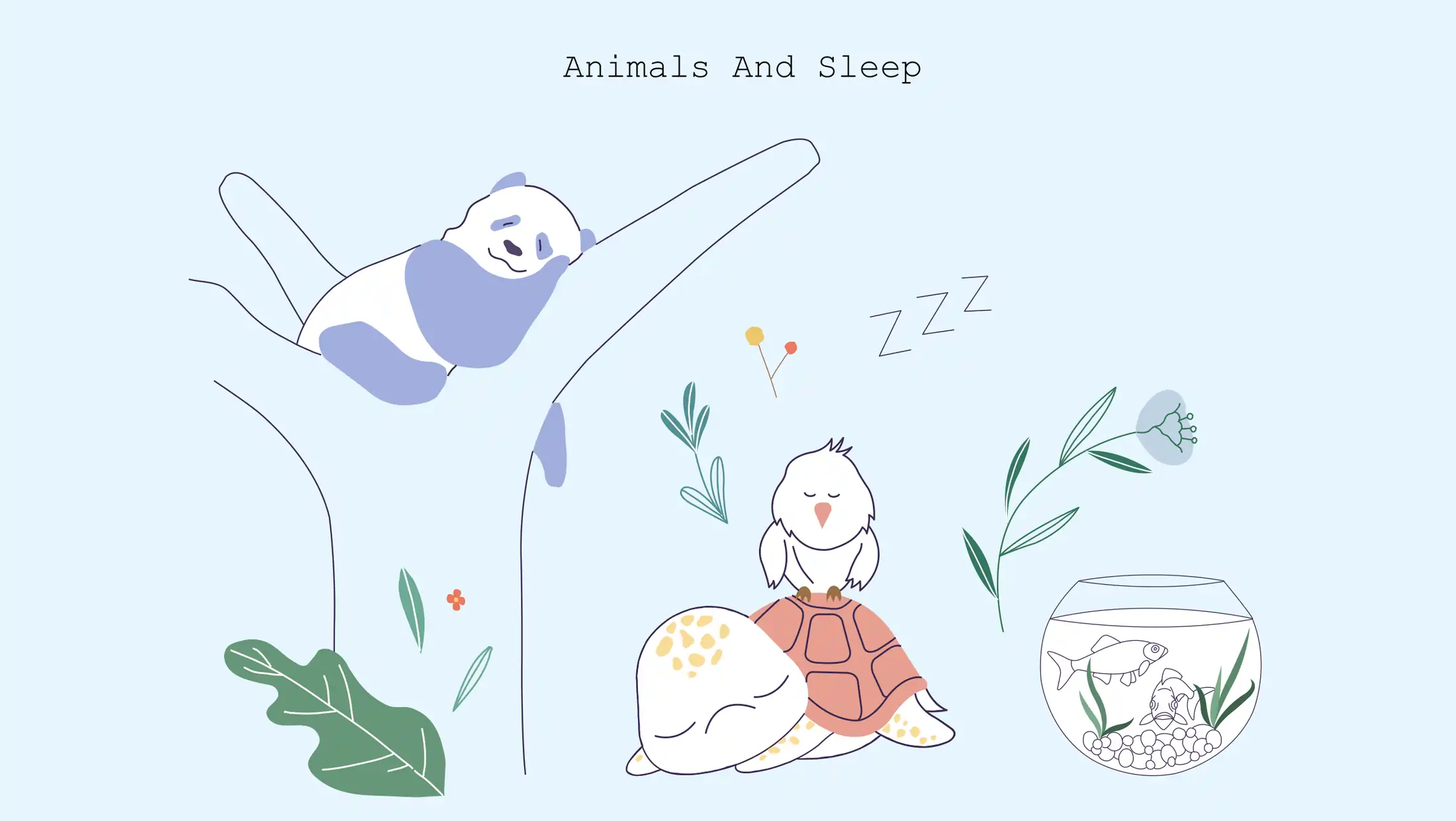How Do Different Animals Sleep?
Written by


Sleep is vital, and occurs naturally in all animals. However, the sleep patterns are as varied as the animal kingdom itself. And even though animals and sleep have a vast array of different species and ways, all of them, even bacteria, adhere to a 24-hour cycle, known as a circadian.
A circadian rhythm is the sleep-wake pattern of an animal for a 24-hour day. Apart from the different sleep cycles, all animals have different ways and purposes for sleeping, such as certain animals sleep standing up or with their eyes open.
Following that, which animals stand and sleep? Which animals open eyes and sleep? And lastly, why and how do they sleep?
Read down and look closely at the animal kingdom and their sleeping habits.
Why Do Animals Sleep
Sleep is common in all living beings, all from flies, and humans, to whales and bears. And even though it limits the ability to defend against predators and prevents essential activities such as mating and food collection, researchers theorise that sleep has a crucial evolutionary function.
For instance, insufficient sleep affects cognitive function, lowered immunity, increased risk of disease, and sexual and maternal behaviours in animals. It also helps them retain their memory and learn new things. Besides these, sleep assists with other functions, such as:
- Help the brain restructure and reorganise, especially after an injury.
- For some species, sleep helps save energy.
- Sleep may also facilitate neurogenesis.
Hibernation vs Sleep
Sleep is reduced responsiveness and inactivity, whereas hibernation is a seasonal heterothermy characterised by low body temperature, slow breathing and heart rate, and low metabolic rate. And unlike the states of coma, hibernation and death, sleep can be rapidly reversed.
In fact, unlike sleep, which facilitates the aforementioned bodily and psychological functions, hibernation is a mechanism in certain animals to adapt to specific environmental changes such as during winter, to increase their chances of survival. It is a state where an animal’s body temperature, heart rate, breathing, and other metabolic activities slow down significantly to conserve energy during hard times and in case of scarce resources.
Carnivores vs. Herbivores: Sleep Patterns
Different species of animal and sleep patterns are measured depending on several variables. These variables include that sleep expression is adapted to ecological factors and may differ qualitatively across species. So, how do different animals sleep?
Herbivores have developed ways to protect themselves from predators during sleep. Unlike carnivores, which tend to sleep more than herbivores, evaluating that the fear of predators plays a role in varying sleep patterns across species. For instance, some animals may sleep standing up or with their eyes open.
So, which animals stand and sleep? And which animal open eyes and sleep?
Cows, elephants, and giraffes sleep standing up since it’s easier for them to run away if they’re already standing up. Whereas horses sleep with their eyes open and standing up, to protect themselves. Following this, how much do different animals sleep? The animals have different sleep cycles per day, across the species, some of which are mentioned in the following.
- Goat – 5.3 hr
- Cow – 3.9 hr
- Elephant – 3.9 hr
- Sheep – 3.8 hr
- Rabbit – 11.4 hr
- Jaguar – 10.8 hr
- Duck – 10.8 hr
- Dog – 10.6 hr
- Lion – 13.5 hr
- Tiger – 15.8 hr
- Cat – 12.1 hr
Why Animals Sleep Differently
As aforementioned, different species of animal and sleep patterns vary on several variables. These aspects of sleep include environmental influence, metabolism, diet, body mass, and their unique psychology.
Sleep and Metabolism
It is known that the brains of animals with faster metabolisms contain more significant numbers of neurons, while the neurons in the brains of larger animals are less dense. And the secret to the way animals sleep may also lie in their brains since it is what generates more waste by-products called metabolites. And accumulated waste products in the brain cause animals to fall asleep.
Body Size & Diet
Another theory about animals and sleep is that larger animals need to eat more to sustain their muscle mass. The reason for this robust correlation is unknown, but the possible explanations include the inverse correlation of metabolic rate with body mass, brain mass, and a species’ customary diet.
For instance, sleep time is inversely correlated with body mass in herbivores, unlike the calorie-dense diet of carnivores. Similarly, larger animals tend to move more slowly than smaller animals, which explains their reduced need for sleep. Nonetheless, the relationships between weight, sleep time, and diet are apparent.
Sleep and Immunity
Sleep is an enigma. And scientists have found an association between sleep and immunity. It states that animals exposed to more pathogens may have evolved to sleep in consolidated blocks of time so that energy could be directed to the immune system. For example, according to a finding, dynamic changes in sleep throughout an infectious disease in rabbits aided in recuperation.
Animal Sleep Behaviours
We know why animals sleep, and what their sleep patterns are. Now let’s discuss how do different animals sleep.
Circadian rhythm is the sleep-wake pattern of an animal for a 24-hour day. It means, that when an animal sleeps it depends on its environment, feeding habits, and vulnerability to predators. This circadian rhythm consists of different behaviours, namely,
- Diurnal rhythm is when the animals are active during the day and rest at night.
- Nocturnal rhythm, on the other hand, is when the animals are active during the night.
- Crepuscular rhythm is when the animals are most active at dawn and dusk, on cloudy days and bright nights. They are also likely to adapt to the behaviour of predators, who tend to be most active at night or in full daylight
- Metaturnal rhythm is when the animal is not diurnal, nocturnal, or crepuscular, and is distinguished by random and irregular activity at all times of the day.
How Mammals Sleep
Mammals are warm-blooded vertebrates, characterised by the presence of mammary glands which in females produce milk for feeding their young, a neocortex, fur or hair, and three middle ear bones. Regardless of differences in size and physiology, all mammals share certain aspects of sleep; they all experience the REM cycle alternating with non-REM, where REM is the dreaming stage in mammals.
And though all mammals experience REM sleep, it’s still a matter of duration. For example, mammals who are born in a more fully developed state such as horses experience more non-REM sleep than less developed animals, like cats and human beings.
Land Mammals
Land mammals amount to various sleep durations ranging from species to species. Though giraffes naps during the day, they generally tend to sleep during the night, standing up. Besides, Giraffes need surprisingly less sleep, which is as little as 30 minutes per day. Another larger mammal that sleeps very little is elephants, they sleep for two hours per day.
Similarly, deer and sheep sleep 3 to 4 hours per night, whereas sheep typically sleep in a herd for added protection. Besides the duration, there are also different ways of sleeping among the different species. For example, unlike monkeys, which sleep sitting upright, great apes like orangutans, gorillas, chimpanzees, and bonobos prefer to lay down upon constructed nesting platforms in trees.
Marine Mammals
The sleep in marine mammals is different from the terrestrial. All terrestrial mammals display two sleep stages: slow-wave sleep (SWS) and rapid eye movement (REM) sleep, where immobility is a key sleep feature in terrestrial mammals. Meanwhile, aquatic mammals have specific behavioural and physiological adaptations preventing excessive heat loss or overheating by maintaining postures or motion and excluding prolonged periods of immobility when sleeping in water.
Dolphins, porpoises, and eared seals have only one sleeplike state, called unihemispheric slow-wave sleep (USWS). During unihemispheric sleep, the homeostatic function involves one side of the brain remaining half-awake during circadian rhythm cycles. Therefore, and due to the half-sleep/wake during the unihemispheric sleep, researchers conclude the absence of the REM cycle in marine mammals.
How Do Birds Sleep
Similar to mammals, birds have two states of sleep across their species. Some birds experience shorter episodes or “bouts” of REM sleep. And depending on the species of bird, they might be diurnal, nocturnal, metaturnal, or crepuscular.
Meanwhile, In other species, sleep and wakefulness occur in unihemispheric sleep. Especially in the migratory birds. During the long flights when REM sleep seems impossible and dangerous, they either don’t sleep or have a unihemispheric sleep while gliding, when their wings don’t need to flap as much.
How Do Reptiles and Amphibians Sleep
Once, it was believed that reptiles’ sleep patterns vary from other animals due to the structure of their brains. However, later research indicates that reptiles such as lizards also experience similar sleep patterns to human beings and other mammals.
The sleep patterns in lizards include a common origin of two sleep states, that is REM sleep and slow-wave sleep (SWS) (or non-REM sleep), with the diurnal circadian rhythm. In addition, when preparing to sleep, reptiles require safety from predators, therefore the sleeping sites are carefully selected for specialised terms of structural and thermal properties.
How Do Fish Sleep
Although fish have no eyelids, they still experience slow-wave sleep and REM sleep. Similar to mammals and other animals, fish’s vital signs decrease during sleep, such as heartbeat and breathing.
A notable difference between fish sleep and human sleep is they are not tied to a particular phase or cycle. Instead, there are documented switches from nocturnal rhythm to diurnal rhythm, or vice-versa, in fishes. Furthermore, these switches from nocturnal to diurnal rhythm can occur according to the seasons.
Final Thoughts
The world of animals is fascinating. The above article’s diversity illustrates the magnetic sleep variations among animal species. Even though sleep characteristics vary widely across species, sleep is vital and serves specific purposes in all animals, from a few centimetres of insects to an eighteen-foot giraffe. Sleep also illustrates the crucial importance of the health and well-being of all living things.
FAQs
What animal is most associated with sleep?
Koala sleeps for 20 to 22 hours out of 24 hours. Sloth and brown bats are also known to sleep for around 20 hours a day.
What animals sleep standing up?
Elephants, zebras, and horses all snooze when upright. Cows can also sleep while standing, however, typically choose to lie down.
Why sleep is important for animals?
Sleep is necessary to restore the brain’s glycogen stores, which deplete during awake hours. This notion is supported by the fact that many animals, including humans, sleep at night.
Do animals need sleep like humans?
Yes, almost all creatures, including humans, require some kind of relaxation or sleep. The majority of animals have a biological 24-hour clock called the circadian rhythm, which controls their sleep and awake.
Do animals sleep every night?
Although different animals have different sleep schedules, almost all animals do have some type of pattern. Some animals need more than 18 hours of sleep per day, while others just require a few seconds of sleep at a time.
What are the animals that sleep with one eye open?
Dolphins maintain some level of awareness while dozing off, as they say, with one eye open because they can’t snuggle up and zonk out at night like land mammals as they need to frequently come up for air and watch out for potential predators.
people like this article
Written by








